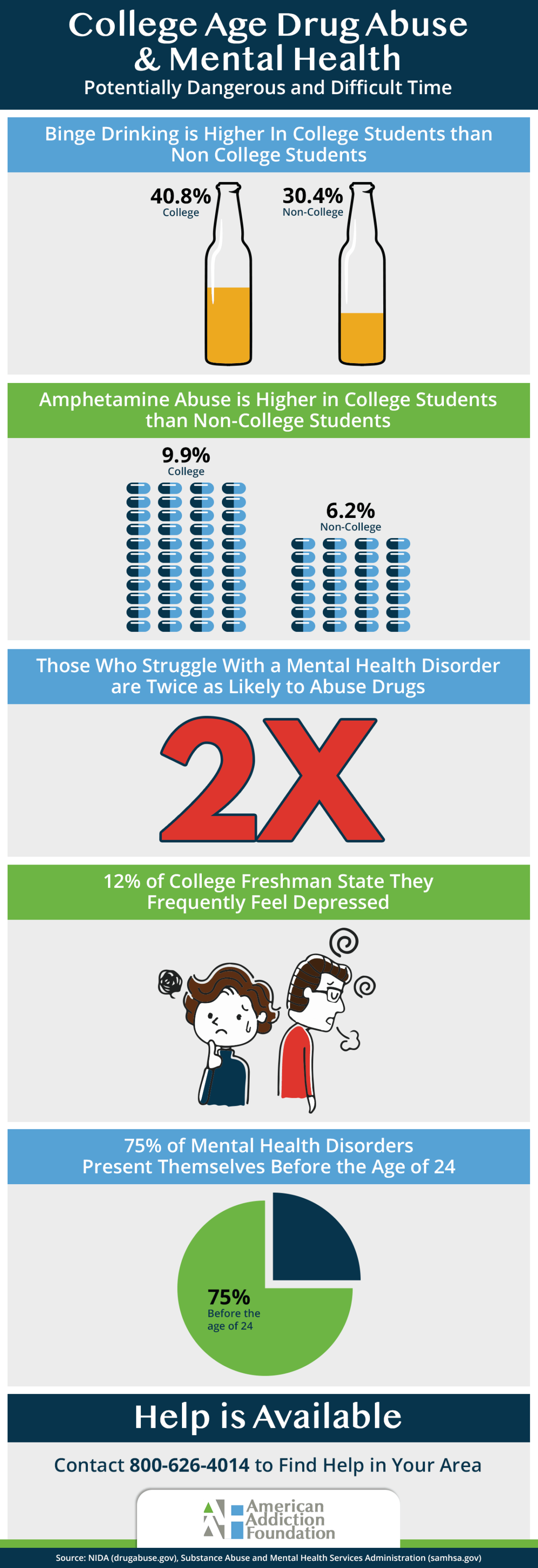The connection between addiction and behavioral & mood disorders like anxiety, depression and PTSD is well established. More and more, government organizations like the National Institute on Drug Abuse (NIDA) and the Substance Abuse & Mental Health Services Agency (SAMHSA) are releasing findings that support a strong connection between mental health disorders and chemical dependency.
If someone is already ‘at-risk’ due to mental health challenges the college experience might be particularly risky for them to unwittingly stoke the fire of a latent addiction. The co-occurring conditions feed into each other in this environment as the student is often experiencing new surroundings, new activities, and new stressors.
College Age Drug Abuse & Mental Health Infographic
We wanted to share this infographic about drug abuse and mental health in college aged students to bring more awareness to this phenomenon. The stress and change in environment experienced in college can stoke the fire of addiction that binge drinking and recreational drug use have lit. The social and educational pressures that students face cause them to act out in various ways, and it’s all too common that recreational experimentation leads to abuse and then full blown addiction. The lack of parental oversight (if the student went away to college creates an even better opportunity for risky and decadent drug experimentation. Other disorders will often reveal themselves during this period, including eating disorders and self harming behavior (like ‘cutting’)
Age 18-25 is Addiction’s Most Common Time To Strike
Obviously, someone can become addicted to a drug (or activity) at any age and, in fact, adults and seniors are becoming addicted to medications in record numbers in the United States. But addiction research has long shown that age 18-25 is a very common time for men and women to develop a chemical dependency. To further complicate matters, mental health problems often reveal themselves in early adulthood, with 75% of mental health disorders presenting themselves by age 24. The result is that college age kids are dealing with a lot of internal factors that could have destructive results if not managed constructively.
The Popularity of Opiates Makes the Risk of Fatal Overdose Higher Than Ever
Now more than ever is the time to keep a close eye on the ‘at risk’ teens and early adults. The reason is that opioid medications are causing a previously unseen death toll in young adults (and people of all ages). Young adults aged 18-25 are the most prolific abusers of prescription drugs. The transition to stronger and stronger substances like fentanyl and heroin just increases the risk of a potential overdose. Mixing the drugs with alcohol or commonly prescribed anxiety medications like benzodiazepines in particular greatly increases the likelihood of overdose and can have devastating results.
If you know someone who is ‘at risk’, it’s strongly recommended that you take action sooner than later. The Substance Abuse & Mental Health Services Agency (SAMHSA) can be a great place to start, you can call any facility in their directory for a complimentary and confidential assessment of your situation.

